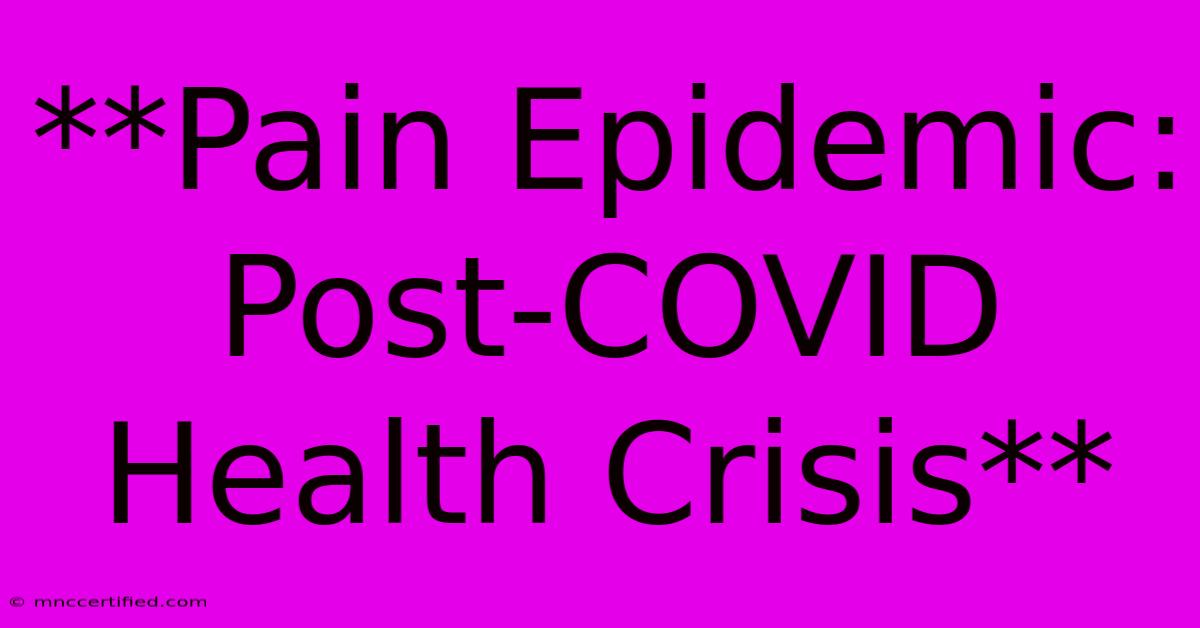**Pain Epidemic: Post-COVID Health Crisis**

Table of Contents
Pain Epidemic: Post-COVID Health Crisis
The COVID-19 pandemic has left an indelible mark on global health, but the lasting impact goes far beyond the initial respiratory symptoms. A growing body of evidence points to a post-COVID pain epidemic, with millions experiencing persistent and debilitating pain, a new and alarming development in the wake of the pandemic.
The Rise of Long COVID and Pain
Long COVID, also known as post-acute sequelae of COVID-19 (PASC), encompasses a wide range of symptoms that can persist for weeks, months, or even years after the initial infection. While fatigue, brain fog, and shortness of breath are common, pain is a major symptom experienced by a significant proportion of long COVID sufferers.
Studies have found that up to 80% of individuals with long COVID experience persistent pain, often in multiple body regions. This pain can manifest as:
- Musculoskeletal pain: This includes pain in muscles, joints, bones, and connective tissues.
- Neuropathic pain: This type of pain stems from damage to the nerves and can cause burning, tingling, numbness, and shooting sensations.
- Headache: Chronic headaches and migraines are common in long COVID.
- Chest pain: Persistent chest pain, unrelated to breathing difficulties, is another concerning symptom.
Understanding the Mechanisms Behind Post-COVID Pain
The exact mechanisms behind post-COVID pain are still being investigated, but several potential contributing factors have been identified:
- Inflammation: COVID-19 can trigger widespread inflammation throughout the body, which can lead to persistent pain.
- Neurological damage: The virus can affect the nervous system, leading to neuropathic pain and other neurological complications.
- Autoimmunity: Some researchers suggest that COVID-19 may trigger autoimmune responses that target various tissues, causing inflammation and pain.
- Psychological distress: The psychological impact of COVID-19, including anxiety and depression, can worsen pain perception and contribute to chronic pain conditions.
The Impact on Individuals and Healthcare Systems
The post-COVID pain epidemic presents a significant challenge for individuals and healthcare systems alike.
- Individual impact: Persistent pain can severely impact daily life, affecting work, relationships, and overall quality of life. It can lead to disability, isolation, and increased healthcare utilization.
- Healthcare system impact: The surge in post-COVID pain cases puts a strain on healthcare resources, requiring additional funding and personnel to address the growing need for pain management and rehabilitation services.
Strategies for Addressing the Pain Epidemic
While research into the causes and treatments for post-COVID pain continues, several strategies are crucial for addressing this emerging health crisis:
- Early identification and management: Prompt recognition and management of pain symptoms in individuals with long COVID are crucial.
- Multidisciplinary care: A comprehensive approach involving physicians, pain specialists, physical therapists, occupational therapists, and mental health professionals is essential for effective pain management.
- Research and development: Continued investment in research is needed to unravel the underlying mechanisms of post-COVID pain and develop targeted treatments.
- Public awareness: Raising public awareness about post-COVID pain and its potential impact is vital to encourage early help-seeking and support for those affected.
Conclusion
The post-COVID pain epidemic is a serious health challenge that requires urgent attention. Recognizing the multifaceted nature of this issue, implementing comprehensive strategies for early identification, multidisciplinary care, and research is paramount. Through collaborative efforts, we can work towards alleviating the suffering of those affected by this debilitating condition and build a more resilient healthcare system to meet the needs of the future.

Thank you for visiting our website wich cover about **Pain Epidemic: Post-COVID Health Crisis**. We hope the information provided has been useful to you. Feel free to contact us if you have any questions or need further assistance. See you next time and dont miss to bookmark.
Featured Posts
-
Deco Secures Deal Cubarsi Gives Transfer Price
Nov 07, 2024
-
Psg Transfer Confirmed 40 Million Deal Flicks Joy
Nov 07, 2024
-
Single Involuntary Unemployment Insurance
Nov 07, 2024
-
Uk Trade Sanctions Datas Crucial Role In Compliance
Nov 07, 2024
-
Rigetti Meets Nasdaq Listing Standards
Nov 07, 2024